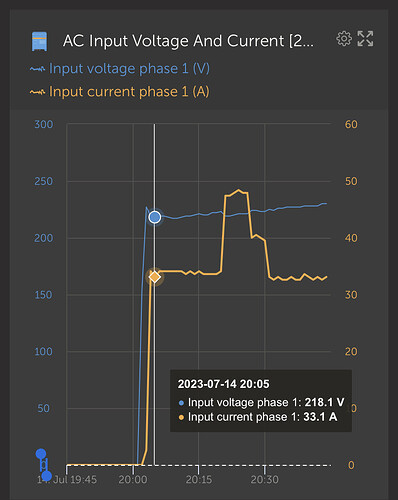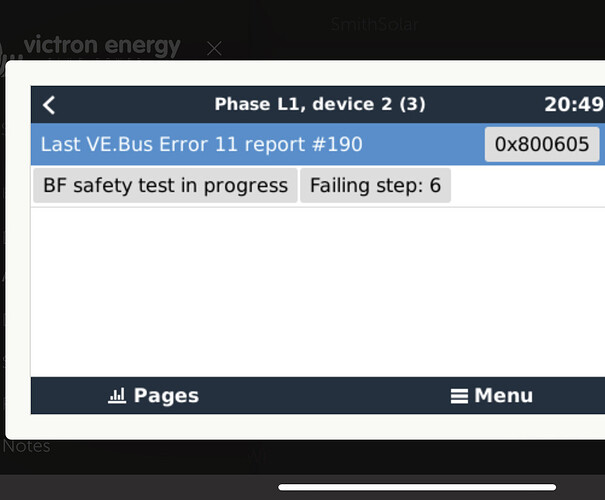Right, so maybe a value between 600 and 900 seconds becomes even better. But that is way beyond what NRS097 allows if I recall.
Was NRS097 written way back with LS Level 6 in mind? Was it ever considered how bad things did get?
Don’t think so.
Yes, hence I hope my Tripconnect will be installed tomorrow. My preferred sparky is beyond busy for months now.
I want 5 minutes min plus the Victron 60+ seconds.
We have a constant 242v here, so I want to cut Eskom feed off at 246v max and 220v min, let the inverter take over for the waiting period.
EDIT: I am fully aware that stuff will go off if the parms are too narrow BUT rather I cause the “LS”, than Eskom damaging more stuff. My one freezer is taking serious strain AND it is on Cirtical Loads. May times when LS starts I can hear the motor rattle.
Somewhat related, hence jumping on this thread
Had LS end, followed by inverter trip
Very low grid voltage:
This error:
Are those likely related?
Or do I have to go hunting for more earthing faults?
Edit: sorry, I see now this is probably the wrong subforum for this post.
The voltage looks ok…
https://www.victronenergy.com/live/ve.bus:ve.bus_error_codes
Error 11 is there, with steps to test.
Also found this …
https://community.victronenergy.com/questions/2709/multiplus-ii-and-vebus-error-11.html
And this … mine was weird, 8 am AFTER LS started … my suspicion on the end was the panels and their wiring.
But lots of ideas to try there.
Step 6 means: AC1RMS > 100V while only K1 closed.
To understand the relay notation, it is laid out like this:
Live ---------- K1 -------+------------- K2 ------------> Inverter/AC-out
|
V
Measure here
^
|
Neutral ------- K3 -------+------------- K4 ------------>
K1 is closed and everything else is open. That means there should be no voltage at the measurement point, yet there is more than 100V. K3 is probably faulty. Or as in TTT’s case, some sort of radio noise causes a ghost voltage reading.
Ghost … yes, I concur with that. I did measure in the end, accidentally, a “radio noise” voltage on 1 set of spare wires in the combiner box … not forgetting the teeny doubt floating around in the back of my mind around the earthing of said arrays at that time.
Well this is a thing where I live. Last night I noticed that my inverter was not getting any grid input. When I checked further I found that there was grid, but the inverter had disconnected.
Why?
Grid was at the 259 to 260 V range.
Today, so far, I have had 8 disconnect events for the same reason - grid voltage out of range.
Currently it is sitting ay 235, but 10 minutes ago it was 245, last night we were seeing it over 250 for long periods of time and at least once it hit 260.
I’m guessing part of this is because so many folks are on holiday, businesses have closed down, so load is reduced.
A while back we had lots of properties in the area reporting low voltage, often < 190. City Power addressed that. I don’t KNOW, but I am supposing they just changed the tap being used on the output side of the transformer. I remember our supply going down completely, then coming back up 10 or 15 minutes later but with voltage higher.
Looks like an unintended consequence of that is high voltage when demand in Johannesburg is low.
But the fluctuations do strike me. It can be 20 to 25 V in an hour. Though maybe it’s always been that way and I just never noticed.
My inverter has disconnected 8 times since midnight for voltage out of range. It expects 207 to 253 V.
And that is exactly why I had a Tripconnect installed, to disconnect at 250v before the inverter has to protect itself.
Was also the moment I realised, all the circuits that are not on the inverter, non-critical loads, are taking some serious strain when Eskom volts goes up.
What also transpired, the transformer in the street was “fine tuned” couple of years later. Since CoCT did that, no more “self inflicted LS” by the Tripconnect.
City Power are not very good at explaining what they are doing and why, but what seems to be the case round where I live is that the voltage has been raised to reduce the current the cables must carry.
I note that up until 6:33 this morning my inverter had disconnected 8 times. Since then nothing. Currently sitting around 245.
Or to increase the power they can carry.
Or the transformer is old, needs urgent maintenance/adjustment …
The grid voltage once went over 280v in our suburb. Ofcoarse my inverter disconnected long before that, like yours around 250v or something.
That said, that night, a bunch of people lost appliances. Fridges etc. Even asked me to provide graphs from my inverter showing what happened to show their insurance companies what happened.
Pretty sure, I also have a surge connecter before my inverter, but this tripconnect thing sounds like something I should also look in to.
Your backed up loads are protected because the inverter drops off of the grid, thus fullfilling the role of the tripconnect. It is only the other loads that are exposed.
I would install a trip connect on the main AC in (Grid). You don’t really want the inverter switching 10 times per day. Wear and tear and all that. Also way more inconvenient to replace… Plus you protect all the downstream appliances.
But surely it will switch? It will just see the grid feed vanish, still have to disconnect to satisfy the safety codes, and will behave just as it did if there was loadshedding.
Agree but what about all the other appliances… I’m thinking a bit broader. Also if you set your TC very strict it will not reconnect until the voltage has stabilized for a period. so less “trips” on the inverter side.
Well this is what I don’t know. Possibly exposed on my system are the guest geyser which is usually off but has an element for heating. There’s the washing machine which is very new and has an inverter drive. The pool pump (old and unsophisticated, not one of the new varispeed pumps). The tumble drier (which we never use, but is still plugged in, I think it has an inverter). And maybe our old (16, 17 years) electric lawn mower if that’s in use at the time.
I don’t know what can be damaged by high voltage, and my basic understanding is that if voltage is up, current is down and so there’s less chance of cables burning.
Clearly there’s a limit somewhere. My pool pump might tolerate 250V, even 260, but it won’t put up with a 1000. Or maybe it will. Here I am a supplicant seeking greater enlightenment.
Both over and under voltage can damage equipment/appliances.
The geyser element is probably the only thing not to be at risk.
10% over or under the rated mains voltage is ok, but over 250V would start making me nervous.
But get the appliance manuals out and check the specs…
Consider this: 220v appliances.
Now there are safety margins, like inverter disconnecting at ±250v, think Victron is 255v.
Cost of replacing:
- washing machine which is very new and has an inverter drive
- old pool pump that can still work for a while
- tumble drier
- old mower prematurely
… and anything else you may have missed accidently.
vs
The cost of a Tripconnect + installation to disconnect your property from the grid when the volts go above 250.
That is the sum you need to make.
Ps. You already suffered losses for unknown causes?

